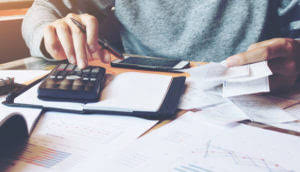
In this method, the asset account is charged (credited) with depreciation. There is one disadvantage of this method, which is that it is not possible to find out the original cost of an asset and the total amount of depreciation. At the end of the year, Company A uses the straight-line method to calculate the depreciation for the van, arriving at an annual expense of $2,000 ($20,000 purchase price / 10 years of useful life). Since depreciation is not intended to report a depreciable asset’s market value, it is possible that the asset’s market value is is accumulated depreciation a plant asset significantly less than the asset’s book value or carrying amount. The accounting profession has addressed this situation with a mechanism to reduce the asset’s book value and to report the adjustment as an impairment loss. Depreciation is recorded in the company’s accounting records through adjusting entries.
Example of a Loss on Sale of an Asset
Since accumulated depreciation only applies to fixed assets—not your stash of petty cash or those office supplies—you’ll see it in the fixed assets section. Companies https://sklep16.studio112.pl/2024/08/09/how-to-record-a-sales-journal-entry-accurately/ often have a dedicated PP&E section to separate these long-term assets from current assets. The accumulated depreciation account pairs up with the related asset account to show the asset’s net book value.
Declining balance technique
Asset cost minus anticipated salvage value divided by anticipated years of use equals ($750 – $75) divided by anticipated years of use equals $675 divided by six equals $112.50. Asset cost minus anticipated salvage value divided by anticipated years of use equals ($750 – $150) divided by anticipated years of use. When you manage depreciation correctly, you improve cash flow, reduce risks, and reinvest in growth. How to outsource your accounting, even if you can’t afford a full-on CPA. Get free guides, articles, tools and calculators to help you navigate the financial side of your business with ease. Our intuitive software automates the busywork with powerful tools and features designed to help you simplify your financial management and make informed business decisions.
#3 – Sum of Digit Method
- Let us try to understand the depreciation and plant asset disposal methods.
- It’s not considered a current asset because it doesn’t meet the expected criteria of being converted into cash within one year.
- These additional expenditures are considered part of the asset’s cost because they are essential for the asset to be operational and contribute to the business.
- Think of it as the total wear and tear an asset has endured since you first brought it into your business’s loving embrace.
- This cumulative figure is a central concept for understanding how businesses track and report the diminishing value of their long-term assets.
The first step for the retailer is to record the depreciation for the three weeks that the truck was used in January. In DDB depreciation the asset’s estimated salvage value is initially ignored in the calculations. However, the depreciation will stop when the asset’s book value is equal to the estimated salvage value.
- She supports small businesses in growing to their first six figures and beyond.
- Depreciation, in other words, allocates how much of an asset has been used up in a year until the Asset is obsolete or no longer in use while spreading out the asset’s cost over time.
- The “declining-balance” refers to the asset’s book value or carrying value (the asset’s cost minus its accumulated depreciation).
- Property, Plant, and Equipment (PP&E) refers to long-term, tangible assets a business uses in its operations to generate income.
- The company’s policy in fixed asset management is to depreciate the equipment using the straight-line depreciation method.
Then, multiply that rate by the number of units produced in a given period. Long-term or non-current assets are resources a company owns or controls that aren’t expected to be converted into cash or used up within one year of the balance sheet date. These long-term assets are subject to depreciation because they’re expected to benefit the company over an extended period. Accumulated depreciation is crucial for showing the actual value of a company’s assets on the balance sheet and accurately reflecting the business’s financial health.


It lowers the asset’s book value, giving you a clearer picture of its actual worth. In the SYD method, the expected lifespan of the asset is considered, and the digits for each year are added together. The resulting percentages are then employed to determine the annual depreciation, starting with the highest percentage applied in the first year. Unlike straight-line depreciation, this approach accelerates the recognition of depreciation expenses in the early years, reflecting the belief that assets depreciate more rapidly initially. For example, let’s say a company purchases a delivery truck for $50,000.

Let’s assume that a piece of machinery worth 100,000 was purchased on April 1st 2023, with a scrap value of nil and a depreciation rate of 10% (straight-line method). PP&E is a company’s property, plant, and equipment—notably, vehicles, real estate, equipment, and machinery that can’t easily or quickly be sold to raise cash. PP&E is critical to a company’s financial Bookkeeping for Etsy Sellers health because these assets are a key requirement for the company to remain in business. Although they can’t be quickly or easily sold, these assets can be used as collateral for loans. This depreciation is calculated during each reporting period, and the measurements are cumulative. Land appreciates rather than depreciates, so it’s accounted for at market value.
Both corporations and small businesses frequently possess both physical and immaterial assets. Computers, machinery, software, employee uniforms, and vehicles are tangible assets; patents and brand equity are intangible assets. As the estimated lifespan changes, so will the costs for subsequent years. Therefore, in the second year (14/120) x ($50,000 – $2,000), the depreciation expense would decrease to $5,600.
Unit 11: Plant Assets and Intangible Assets
For example, installation, wages paid to install, freight, upgrades, etc. The accumulated depreciation of the van will increase by $2,000 for each year of its useful life. The accounting term that means an entry will be made on the left side of an account. We will illustrate the details of depreciation, and specifically the straight-line depreciation method, with the following example. Since the balance is closed at the end of each accounting year, the account Depreciation Expense will begin the next accounting year with a balance of $0. This entry indicates that the account Depreciation Expense is being debited for $10,000 and the account Accumulated Depreciation is being credited for $10,000.
Okay, So What’s a Contra Asset Account?

This systematic approach ensures that the asset’s final book value aligns with its expected salvage value—the amount you anticipate getting when you finally part ways with it. Depreciation, particularly accounting, deals with spreading out an asset’s cost over time, typically its useful life. When a business buys an asset, like a piece of equipment, such sizable purchases can confusedly skew the income statement. This can be smoothed out in the accounting books by depreciating the Asset throughout its useful life.
 Phone: +4733378901
Phone: +4733378901  Email: food@restan.com
Email: food@restan.com 
